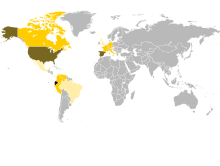This article needs additional citations for verification. (January 2023) |
 | |
 Flag of Ecuador; symbol of Ecuadorian unity | |
| Total population | |
|---|---|
| c. 18.5 million (Diaspora) c. 1.5m | |
| Regions with significant populations | |
| 717,995[3] | |
| 444,347 [4][5] | |
| 66,590[6] | |
| 42,022[7] | |
| 25,410[8] | |
| 16,000[9] | |
| 11,404[10] | |
| 10,249[11] | |
| 9,422[12] | |
| 8,000[13] | |
| 2,627[14] | |
| 2,000[13] | |
| 3,000[13] | |
| 3,000[13] | |
| 2,000[13] | |
| Languages | |
| Ecuadorian Spanish, Indigenous languages | |
| Religion | |
| Predominantly Roman Catholic; Protestant[15] | |
| Related ethnic groups | |
| Other Latin Americans, Indigenous people of the Americas, Europeans | |
Ecuadorians (Spanish: ecuatorianos) are people identified with the South American country of Ecuador. This connection may be residential, legal, historical or cultural. For most Ecuadorians, several (or all) of these connections exist and are collectively the source of their being Ecuadorian.
Numerous indigenous cultures inhabited what is now Ecuadorian territory for several millennia before the expansion of the Inca Empire in the fifteenth century. The Las Vegas culture of coastal Ecuador is one of the oldest cultures in the Americas. The Valdivia culture is another well-known early Ecuadorian culture. Spaniards arrived in the sixteenth century, as did sub-Saharan Africans who were enslaved and transported across the Atlantic by Spaniards and other Europeans. The modern Ecuadorian population is principally descended from these three ancestral groups.
As of the 2022 census, 77.5% of the population identified as Mestizo, a mix of Spanish and Indigenous American ancestry, up from 71.9% in 2000. The percentage of the population which identifies as European Ecuadorian was 2.2%, which fell from 6.1% in 2010 and 10.5% in 2000.[16] Indigenous Ecuadorians account for 7.7% of the population and 4.8% of the population consists of Afro-Ecuadorians.[17][18] Other statistics put the Mestizo population at 55% to 65% and the Indigenous population at 25%.[19] Genetic research indicates that the ancestry of Ecuadorian Mestizos is predominantly Indigenous.[20]
- ^ "World Population Prospects 2022". United Nations Department of Economic and Social Affairs, Population Division. Retrieved July 17, 2022.
- ^ "World Population Prospects 2022: Demographic indicators by region, subregion and country, annually for 1950-2100" (XSLX) ("Total Population, as of 1 July (thousands)"). United Nations Department of Economic and Social Affairs, Population Division. Retrieved July 17, 2022.
- ^ "B03002 HISPANIC OR LATINO ORIGIN BY RACE - United States - 2019 American Community Survey 1-Year Estimates". U.S. Census Bureau. July 1, 2019. Retrieved November 1, 2020.
- ^ "Población por comunidades y provincias, país de nacimiento, edad (Grupos quinquenales) y sexo".
- ^ Immigration to Spain
- ^ "Ecuadoriani in Italia - statistiche e distribuzione per regione". Tuttitalia.it.
- ^ "Servicio de migraciones". www.serviciomigraciones.cl.
- ^ "Ethnic Origin, both sexes, age (total), Canada, 2016 Census – 25% Sample data". Canada 2016 Census. Statistics Canada. 2019-02-20. Retrieved 30 January 2020.
- ^ "Ausländeranteil in Deutschland 2021". Destatis.
- ^ "Censo 2005". DANE. Retrieved 23 May 2013.[dead link]
- ^ "Ecuador - Emigrantes totales". December 2019. Retrieved 8 June 2019.
- ^ "Trends in International Migrant Stock: Migrants by Destination and Origin: Table 16: Total migrant stock at mid-year by origin and by major area, region, country or area of destination, 2015" (XLS). United Nations, Department of Economic and Social Affairs. 2015. Retrieved 20 December 2016.
- ^ a b c d e "Immigrant and Emigrant Populations by Country of Origin and Destination". migrationpolicy.org. 10 February 2014.
- ^ "Befolkning efter födelseland, ålder, kön och år". Retrieved 23 February 2020.
- ^ The Latin American Socio-Religious Studies Program / Programa Latinoamericano de Estudios Sociorreligiosos (PROLADES) Archived 12 January 2018 at the Wayback Machine PROLADES Religion in America by country
- ^ "Censo de Población y Vivienda 2022". 21 September 2023. Retrieved 21 September 2023.
- ^ "Censo de Población y Vivienda 2022". 21 September 2023. Retrieved 21 September 2023.
- ^ Población del país es joven y mestiza, dice censo del INEC. (Census results, in Spanish) eluniverso.com (2011-09-02)
- ^ Encyclopedia of the World's Minorities (2013), p. 422. Edited by Carl Skutsch
- ^ Zambrano, Ana Karina; Gaviria, Aníbal; Cobos-Navarrete, Santiago; Gruezo, Carmen; Rodríguez-Pollit, Cristina; Armendáriz-Castillo, Isaac; García-Cárdenas, Jennyfer M.; Guerrero, Santiago; López-Cortés, Andrés; Leone, Paola E.; Pérez-Villa, Andy; Guevara-Ramírez, Patricia; Yumiceba, Verónica; Fiallos, Gisella; Vela, Margarita; Paz-y-Miño, César (2019). "The three-hybrid genetic composition of an Ecuadorian population using AIMs-InDels compared with autosomes, mitochondrial DNA and Y chromosome data". Scientific Reports. 9 (1): 9247. Bibcode:2019NatSR...9.9247Z. doi:10.1038/s41598-019-45723-w. PMC 6592923. PMID 31239502. S2CID 195354041.